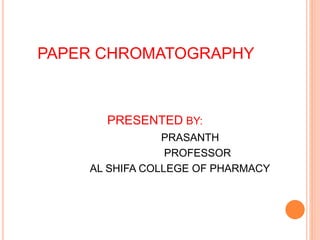
PAPER CHROMATOGRAPHY-PRAS.ppt
- 1. PAPER CHROMATOGRAPHY PRESENTED BY: PRASANTH PROFESSOR AL SHIFA COLLEGE OF PHARMACY
- 2. DEFINITION Paper chromatography is the technique in which the separation of an unknown substance is mainly carried out by the flow of solvents on the specially designed chromatographic paper.
- 3. PRINCIPLE Principle involved is –PARTITION COEFFICIENT PHENOMENON. Substances are distributed between two liquids STATIONARY PHASE ( moisture held in the fibers of the paper) MOBILE PHASE (moving liquid or developing solvent). Components of the mixture to be separated migrate at different rates & appear as spots at different points on the paper.
- 4. TYPES OF PAPER CHROMATOGRAPHY PAPER PARTITION CHROMATOGRAPHY PAPER ADSORPTION CHROMATOGRAPHY
- 5. OPERATIONAL TECHNIQUE 1. CHOICE OF PROPER TECHNIQUE. 2. CHOICE OF FILTER PAPER. The choice depends on: -whether used for quantitative or qualitative analysis. -whether used for analytical or preparative chromatography. -whether substances used are hydrophilic or lipophilic,neutral or charged species.
- 6. -Generally WHATMAN filter paper is used. -Choice of particular WHATMAN paper depends upon the type of separation. -Coarser and faster paper. eg. WHATMAN 31 –used when Rf value is wide apart. -Slow papers are used ,eg. WHATMAN 20 – when Rf value is closer.
- 7. WHATMAN filter paper contain: 98-99% -cellulose 0.07-0.01% mineral content -cellulose ether soluble matter ammonia lipophilic substances (waxes,fats) Specially treated or modified filter papers are used like Whatman-phosphate,Whatman-citrate etc.
- 8. 3. SOLVENT General criteria for a good solvent system: Rf value should lie between 0.05-0.85 Difference between Rf values –must be 0.05 Solvents should not undergo chemical reaction. Solvents should not interfere with detection of spots. Composition of solvent system should not alter with time.
- 9. Eg. Of solvents : n-hexane cyclohexane benzene n-butanol ,etc.. Eg of solvent system stationary phase mobile phase water isopropanol-ammonia-water (9:1:2) water n-butanol-acetic acid-water (4:1:5)
- 10. 4. PREPARATION OF SAMPLES -The sample volume of 10-20 having as many g of substance is the ideal quantity to be spotted. 5. SPOTTING - With the help of a graduated micro pipette,the test solutions are applied. 6. DRYING THE CHROMATOGRAM - dried in special drying cabinets being heated electrically with temperature controls.
- 11. 7. VISUALISATION -by chemical methods -chromatogenic or visualising reagents,eg.ninhydrin in acetone for amino acids -by physical methods -iodine chamber,uv chamber for flourescent compounds.
- 12. DEVELOPMENT TECHNIQUES 1.ASCENDING DEVELOPMENT -solvent flows against gravity. -spots kept at bottom portion of paper. -the development of paper is done by allowing the solvent to travel up the paper. -in this mobile phase is placed in a suitable container at the bottom of the chamber and the paper is suspended from a hook.
- 14. 2.DESCENDING DEVELOPMENT - solvent holder at top & also spot at top of paper - Solvent flow assissted by gravity. - The development of paper is by allowing the solvent to travel down the paper. - The apparatus consist of a well sealed glass tank provided with mobile phase at upper portion. - Development is faster.
- 16. 3.ASCENDING -DESCENDING -combination of both -upper part of ascending chromatography –folded over a glass rod allowing to change into descending . 4. RADIAL PAPER CHROMATOGRAPHY -also known as circular paper chromatography. -radial development takes place.
- 18. 5. TWO DIMENSIONAL DEVELOPMENT -square or rectangular paper is used. -sample applied to one of the corners. -2nd development is done at right angle to the direction of the first run using another solvent system.
- 19. MIGRATION PARAMETERS RF VALUE RF = distance travelled by solute distance travelled by solvent front value ranges from 0-1 RX VALUE RX = distance travelled by sample distance travelled by standard value is closer to 1
- 20. RM VALUE RM = log (1/R F-1) RF values of chemical related compounds are very close. RF values depend on: Solvent employed Medium for separation Nature of mixture Temperature Size of chamber
- 21. APPLICATIONS 1.Analysis of polar compounds like amino acids,sugars,natural products. 2.Separation of mixtures of drugs of chemical or biological origin,plant extracts etc.. 3.Separation of carbohydrates,vitamins,antibiotics,proteins,alkaloids,glycosi des. 4.Identification of drugs 5.Identification of impurities
- 22. 6.Identification of foreign substances in drugs. 7.Identification of decomposition products 8.Analysis of metabolites of drugs in blood,urine etc